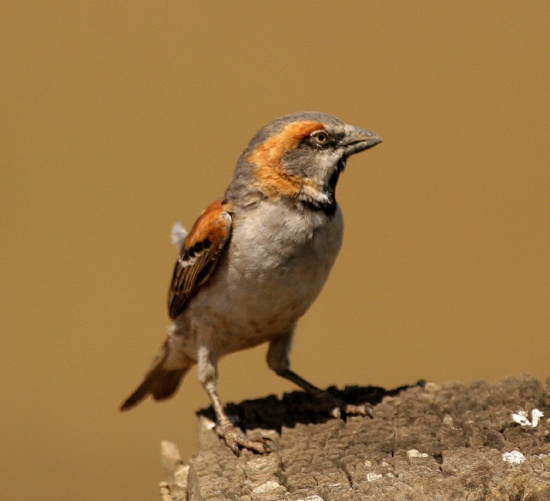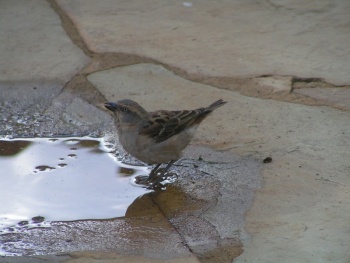Alternative name: Kenya Rufous Sparrow
- Passer rufocinctus
Identification
13 - 15cm.
Male
- Blue grey crown to upper mantle, ear-coverts and cheek
- Black lores, chin and throat
- Broad chestnut band extending from above eye around rear of ear-coverts and on neck side forward
- Rufous chestnut lower mantle to upertail-coverts, streaked black on mantle and uper back
- Blackish to dark brown upperwing
- Broad white tips on median coverts
- Dark brown tail
- Greyish underparts
- Horn-coloured bill, blackish in breeding season
Female
- Similar to male but much duller
- Dark grey bib
- Chestnut replaced by buff
Juveniles are similar to females but they look paler and washed-out.
Similar species
Smaller than Southern Rufous Sparrow. Note also paler eye, greyer face and more grey on neck and mantle (especially in nominate).
Distribution
Highlands of central Kenya south to northern Tanzania.
Common in most of its range.
Taxonomy
This is a monotypic species.
It has been considered conspecific with Shelley's Sparrow and Kordofan Sparrow in the past.
Habitat
Wooded savanna, arid country, cultivated land and in towns.
Behaviour
Feeds on grain, small seeds and domestic scrap. Nestlings are fed with insects.
Feeds mainly on ground.
Breeds all year, mainly April to June and November to December, coinciding with rains. Breeds solitary. The nest is a dome with a side entrance made of grasses and placed in a tree. Takes sometimes abandonend nests of weavers. Lays 3 - 6 eggs.
References
- Clements, JF. 2010. The Clements Checklist of Birds of the World. 6th ed., with updates to December 2010. Ithaca: Cornell Univ. Press. ISBN 978-0801445019. Spreadsheet available at http://www.birds.cornell.edu/clementschecklist/Clements%206.5.xls/view
- Del Hoyo, J, A Elliott, and D Christie, eds. 2009. Handbook of the Birds of the World. Volume 14: Bush-shrikes to Old World Sparrows. Barcelona: Lynx Edicions. ISBN 978-8496553507
Recommended Citation
- BirdForum Opus contributors. (2024) Kenya Sparrow. In: BirdForum, the forum for wild birds and birding. Retrieved 25 April 2024 from https://www.birdforum.net/opus/Kenya_Sparrow





